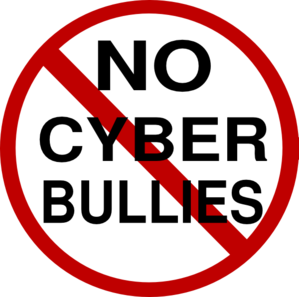Last year my phone was playing up and so my sister performed
a factory reset and I lost all my contacts.
So I constructed a Facebook message with people that were previously on
my contact list or people that I would like to reconnect with asking them to ‘PM’
(personal message) me back with their number.
Unfortunately people added their phone numbers to the bottom of the
message and so people received a great number of notifications and there were
some people (namely two) that said some nasty things. I frantically went into damage control mode
personally messaging the two girls apologising for the message as I did not
intend for it to clog up their inboxes.
This story of cyber bullying unlike many others has a positive ending as
both girls had apologised and more interestingly one girl had not sent the
message at all it was her boyfriend.
CyberBullyHelp states that in both cyber bullying
and traditional bullying the behaviour of bullies is aggressive, repetitive and
power based and the person being targeted has a difficult time defending
themselves (Pagatston 2011). Though
bullying is often repetitive, cyber bullying is particularly repetitive in
nature as the victim can view the message (sent from the bully) multiple times
and I must admit I did read those words multiple times worried that my other
Facebook friends would see (Pagatston 2011).
A key difference between traditional bullying and cyber bullying is that
with traditional bullying the bully is usually known whereas, through cyber bullying
the bully can hide behind fake profiles or in my case use other people’s
identities (Pagatston 2011). Often cyber
bullies would say and do things they wouldn’t normally do believing that they
have anonymity, can hide behind the computer screen and believe that they won’t
get caught (Pagatston 2011). The International Business Times (2012) reported this was
the case with 15 year old Sheniz Erkan, who took her own after have been victim
to constant abuse in the schoolyard and online (Paredes 2012). Her brother acting as a representative for
her family urges parents to be more involved in their children’s online life in
order to protect them and stop cyber bullying (Paredes 2012). He
says that ‘kids can just hide behind
their keyboards, write whatever they want without worrying about the repercussions’
(Paredes 2012).
Unfortunately the dark side of social media extends beyond
cyber bullying we must also guard our children against extremist hate
groups. First Monday states that white extremist hate groups
attempt to attract children with text, MP3 music and games (Rae and Marsh II
2001). Though the efforts of these hate
groups attempt to recruit children to adopt their ideologies the websites are
more reactive than aggressive (Rae and Marsh II 2001).
For example the World Church of The Creator has produced a website Creativity for Kids that offers
downloadable ‘white pride’ colouring pages and crosswords (Rae and Marsh II
2001). This white-extremist group does
not promote diversity in race and colour and are anti-everything except white (Rae
and Marsh II 2001). This particular
website places emphasis on ‘white pride’ and doesn’t particularly take an aggressive
stance on the issue (Rae and Marsh II 2001).
Howard Rheingold envisioned a world where the ‘virtual community’ could exist as a
place where people could come together based a common interest
(Rheingold). However, Rheingold took a
more utopian view towards the virtual community as opposed to white extremist
groups such as the World Church of the Creator who spruik messages of ‘white
pride’ to children.
Currently there are extremist watch groups that keep white
extremist groups in check however, if we were to see the dark side of social
media noticeably shrink in the future our efforts must start at home. Parents should have more of a presence in
their child’s online life if we are to protect them against cyber bullying and
extremist groups.

No comments:
Post a Comment